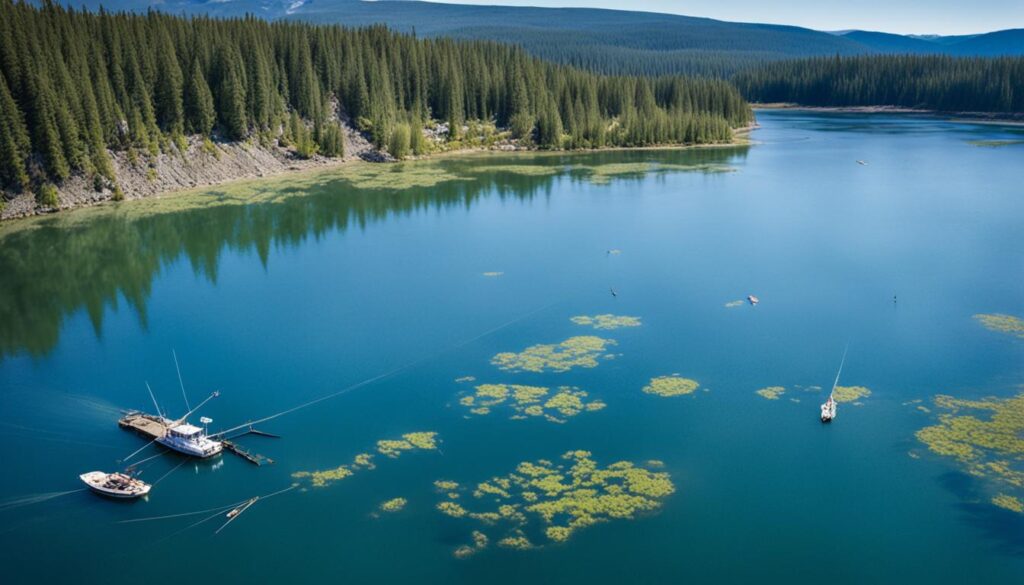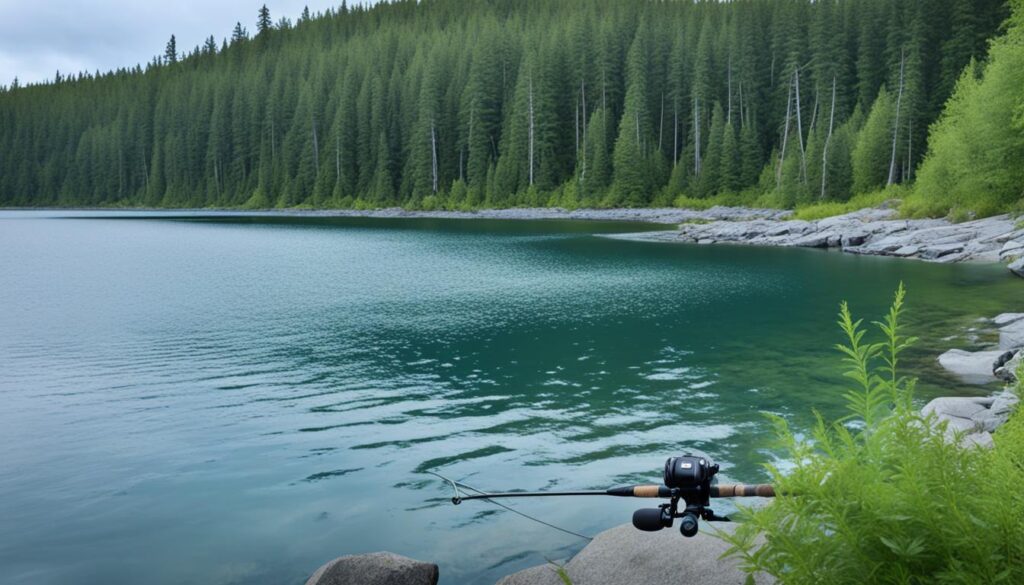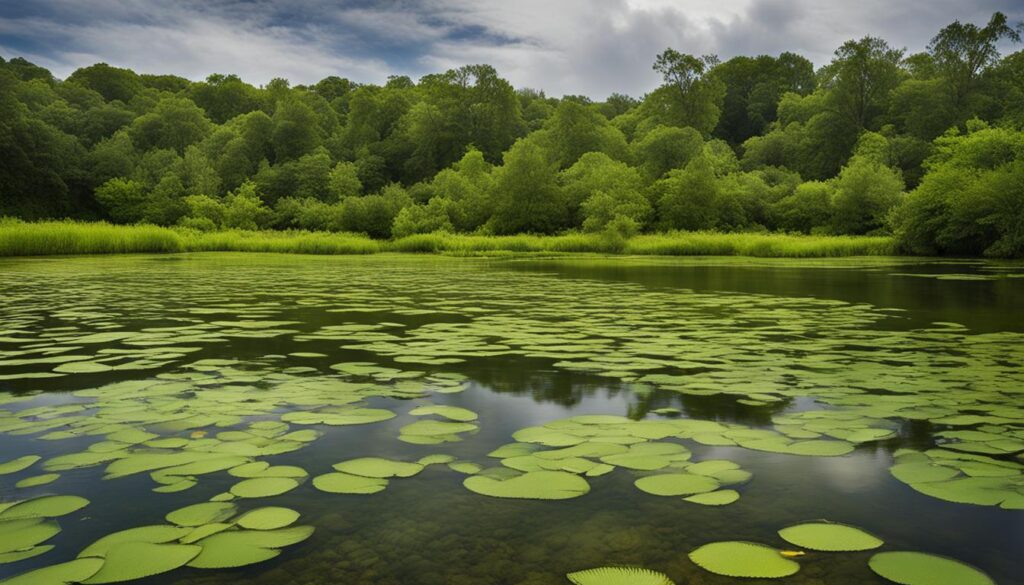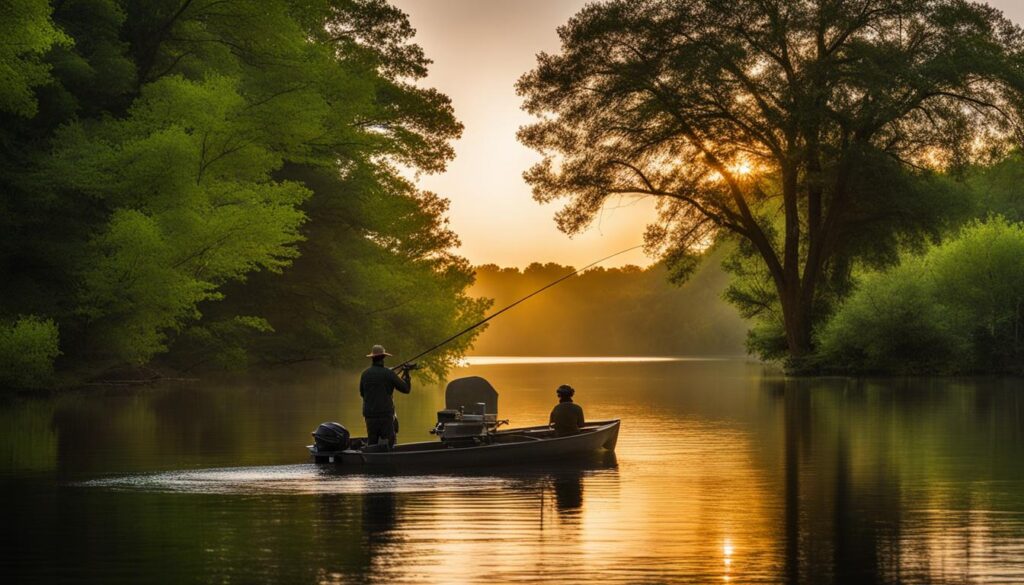Are you ready for some exciting spring bass fishing? As the weather warms and water temperatures rise, bass move from deep creek channels to shallow spawning beds. This is the perfect time to test your fishing skills and reel in big bass. Here are three valuable tips for finding bass around spawning beds to help you make the most of your spring bass fishing adventure.
Key Takeaways:
- Understanding the behavior and science behind the spawning process can increase your chances of catching bass during spring.
- Largemouth bass are territorial and aggressive during spawning, with males guarding the nest.
- Preferred spawning areas include shallow protected coves, flats, and creek channels.
- Baits like wacky rigged Senkos, soft plastic lizards, and crawfish imitations effectively target spawning bass.
- Focusing on warm water inflow, river/creek channels, hardcover, and secondary points can lead to successful spring bass fishing.
The Science Behind Spawning
Largemouth bass are fascinating creatures with unique behaviors, especially during the spawning season. Understanding the intricacies of their behavior can significantly enhance your chances of success when targeting these prized game fish.
During the spawning season, largemouth bass exhibit a territorial nature. The males, known as buck bass, are responsible for nest-building and guarding. They tirelessly use their tails to fan away debris, creating clean patches on the lake or river bottom for the females to lay their eggs.
Once the eggs are laid, the females may stay around the nest briefly before leaving the males to guard and protect the eggs from predators. This nesting behavior ensures the survival of the offspring and is essential for the continued population growth of largemouth bass.
It’s important to note that bass populations in different areas spawn at other times, influenced by water temperature and location factors. Understanding the specifics of local bass behavior is crucial for successful fishing during the spawning season.
“Spawning is a critical phase in the life cycle of bass. By understanding their behavior and habitat preferences, anglers can optimize their fishing strategies and increase their chances of landing trophy-sized bass.” – Professional Angler
Understanding Largemouth Bass Spawning Habits

It’s essential to grasp their preferred habitats and behaviors to catch largemouth bass during their spawning season. These fish meticulously select specific areas, called spawning beds, to lay their eggs and ensure successful reproduction.
Preferred Spawning Areas: Largemouth bass favor shallow, protected coves and flats for spawning. These locations offer the tranquility and seclusion crucial for their breeding activities and protect them from predators and disturbances.
Importance of Creek Channels: Creek channels serve as vital pathways for bass, facilitating easy movement between deep and shallow waters. Bass rely on these channels to navigate from their wintering grounds to their spawning sites, enhancing their accessibility during this critical period.
Role of Structure: Structural elements like logs, rocks, and brush near spawning areas offer additional protection for bass nests. These structures create a secure environment where bass can safeguard their eggs and fry, increasing the chances of successful reproduction.
Optimizing Your Fishing Strategy: Understanding bass preferences during spawning season can significantly boost your fishing success. By targeting these preferred areas and emphasizing the significance of the structure, you can effectively locate and catch spawning bass, enhancing your overall fishing experience.
Optimizing Baits for Spawning Bass
When targeting spawning bass, selecting baits that tap into their territorial and defensive instincts is paramount. Here’s a breakdown of effective choices:
- Creature Baits:
- Include craw baits like Rage Craws or Brush Hogs and lizards like the Zoom Lizard.
- Flapping appendages mimic predators, enticing bass to strike and protect their beds.
- Soft Stickbaits:
- Utilize wacky-rigged Senkos or similar stick worms.
- These can be fished weightless and worked slowly around beds, offering versatility.
- Neko rigging allows the bait to stand up vertically when retrieved, adding to its allure.
- Spinnerbaits:
- Opt for a 1/2 oz spinnerbait as a search bait to cover water quickly.
- It is ideal for triggering reaction strikes from aggressive spawners.
- Buzzbaits:
- Excellent for shallow and easily visible spawning fish.
- Provokes huge strikes as bass defend their beds.
- Drop-Shot Rigs:
- Shake the bait directly in a bass’s face on the bed for effectiveness.
- Use a short 12″ drop to keep the bait close to the bottom.
- It is particularly useful when fish are lethargic or pressured.
Baits that mimic prey and predators trigger bass instincts to protect their nests. Vary your presentation by covering water quickly with reaction baits or making precise casts to specific beds, maximizing your chances of success.
Optimizing Bait Colors for Spring Spawning Bass
Preferred bait colors for spawning bass in spring include:
Natural/Translucent Colors:
- Pumpkinseed
- Watermelon red/red flake
- Green pumpkin
- Smoke/translucent
These subdued, natural hues are effective in clear water, allowing the bass to discern bait details easily. Translucent baits with metallic flakes add extra flash to attract spawners.
Bright/Contrasting Colors:
- White
- Bluegill patterns
- Chartreuse tails
White and bluegill patterns imitate common prey that male bass protect on their beds. Contrasting chartreuse tails can trigger reaction strikes.
Match bait color to water clarity—opt for natural shades in clear water and brighter hues in stained or dingy conditions. Stick with colors that have proven successful in building confidence. Additionally, crawfish patterns can be effective, as bass feeds on them pre-spawn.
Locating Spawning Bass in Spring: The Role of Warm Water

Warm water is pivotal in locating spawning bass during spring. Northern bays warm up faster than other lake areas, receiving ample sunlight. This warmth and increased sunlight exposure make northern bays prime hotspots for active, feeding bass during the spawn.
Key Strategies for Success:
Targeting these warm-water areas significantly boosts your chances of catching bass during this season. The combination of warmth and sunlight creates an inviting environment where bass congregate, becoming more active and aggressive toward the bait.
When fishing in northern bays, prioritize areas with optimal sunlight exposure and warm water temperatures. Focus on shallow spots near structures like fallen trees, docks, or rocky points, offering additional cover for spawning bass. You can effectively locate and entice bass on their spawning beds by thoroughly exploring these areas and experimenting with various baits and techniques.
The Power of River and Creek Channels

Witnessing bass movement during spawning is a captivating experience. These fish ingeniously utilize river and creek channels as underwater highways, seamlessly navigating from deep wintering holes to shallow spawning areas. It’s akin to discovering their secret passageways to reach their breeding grounds.
Understanding bass behavior and the significance of these channels empowers anglers to intercept them en route. It’s akin to setting up a strategic roadblock to catch fish in transit, greatly enhancing your chances of encountering active, feeding bass during the spawn.
Advantages of River and Creek Channels:
| Key Advantage | Description |
| Efficient Movement | Bass utilizes river and creek channels as efficient pathways between deep and shallow areas, akin to underwater highways. These routes enable swift, obstacle-free travel, optimizing their journey during spawning. |
| Ambush Opportunities | Traveling bass encounter prey items and forage along these channels, creating ideal ambush opportunities for anglers strategically positioned along their path. |
| Structure Utilization | Submerged structures like logs, rocks, and brush often populate river and creek channels, offering bass cover and hiding spots. Bass utilizes these features, reinforcing their preference for these channels during spawning. |
| Concentrated Activity | During spawning, numerous bass converges along these channels, resulting in areas of concentrated activity. Anglers intercepting bass here have heightened chances of encountering actively fed fish. |
The illustration above vividly showcases bass movement during spawning, highlighting their reliance on river and creek channels as vital navigation routes. It’s not just a spectacle to admire; it’s a strategy to capitalize on for successful fishing.
Targeting Bass During Spawn: Leveraging Hard Cover
A smart strategy for catching bass during spawn involves focusing on areas with hard cover. These structures naturally attract bass, offering shelter and warmth essential for their breeding activities. Rocks, metal pilings, and wood are prime examples, known for retaining heat from the sun and becoming even more appealing to bass.
Attraction to Hard Cover:
Bass are drawn to hard cover, especially on bright sunny days when they seek shade and cooler temperatures. Positioning near rocks, metal pilings, or wood allows bass to find relief from the sun while remaining close to their preferred spawning grounds.
Strategic Fishing Approach:
Targeting these areas demands careful observation and precise casting. Look for docks, submerged rocks, underwater metal structures, and fallen trees as potential hiding spots for bass. Capitalizing on these structures significantly boosts your chances of locating active, feeding fish during spawn.
Advantages of Hard Cover in Bass Fishing:
- Heat Retention: Rocks, metal pilings, and wood retain sun-generated heat, attracting bass with warmer water temperatures ideal for spawning.
- Shade and Protection: Hard cover provides shade and protection, offering bass refuge from the sun’s rays and security from predators while guarding their nests.
- Structure and Ambush Points: These structures create natural ambush points for bass to target prey, making them productive fishing areas during spawn.
By strategically targeting areas with hard cover like rocks, metal pilings, and wood, anglers can increase their chances of hooking into active, feeding bass during the spring spawn. Adapt your approach to each body of water’s specific hard cover configurations and observe bass behavior for maximum success.
Water Inflow: Targeting Prespawn Bass
When pursuing prespawn bass, areas with water inflow into a lake are incredibly productive. Creek channels and warm water discharges act as magnets, luring prespawn fish seeking favorable conditions for their annual reproductive rituals.
Targeting Creek Mouths: Focus on creek mouths where creek water flows into the main lake body. This influx brings nutrients and warmer temperatures, attracting prespawn bass preparing to move into shallower water for spawning.
Secluded Areas: The backs of creeks and bays are hotspots for spawning bass. These secluded spots offer the calm and protection bass seek for nest-building during spawning.
Warm Water Discharges: Warm water discharges from power plants or other sources are especially attractive to bass. These areas provide stable temperatures in cooler spring waters, drawing bass and increasing baitfish activity.
Targeting Warm Water Discharges: Focus on where warmer water meets the main lake body, as bass congregate in these spots. Mimic available prey with your bait presentation to capitalize on the bass’ heightened feeding tendencies.
Secondary Points for Female Bass: Target secondary points, the first points inside main lake points, to catch trophy-sized prespawn bass. These points serve as prime staging areas for female bass preparing to spawn.
Approaching Secondary Points: Cast your bait beyond the secondary point, allowing it to sink before retrieving slowly to present a natural lure. Pay attention to subtle bites or tension on the line, as female bass strike less aggressively during prespawn.
Carolina Rig Technique: Utilize the Carolina rig for precise depth control and presentation on secondary points. This rig entices cautious female bass to strike, increasing your chances of landing trophy-sized fish during pre-spawn.
Conclusion: Mastering Spring Bass Fishing
Embarking on the quest to find and catch spring bass during the spawning season is an exhilarating and gratifying pursuit. With effective strategies at hand, anglers can elevate their success on the water.
Understanding the behavior of spawning bass is pivotal in pinpointing their whereabouts. Bass gravitate towards shallow, protected coves, flats, and areas with structure like logs and brush for nest-building. Targeting these spots significantly heightens your chances of encountering spawning bass.
Equally crucial is selecting the right baits. Wacky rigged Senkos, soft plastic lizards, and crawfish imitations are tried-and-tested lures for triggering bass’ territorial instincts. Experimenting with various colors and presentations helps fine-tune your approach to match what the bass respond to best.
Lastly, maintain stealth and keep moving until you locate the fish. Spawning bass can be discerning and finicky, so patience and persistence are paramount. Remain adaptable and open to trying new techniques and locations. Armed with these insights and strategies, you’re poised for a fulfilling and successful spring bass fishing season.
FAQ
How can I find spring bass around spawning beds?
To find spring bass around spawning beds, you can follow these tips: target shallow protected coves and flats, focus on creek channels as underwater highways, look for structure near spawning beds, and use baits that trigger territorial and defensive instincts in bass.
What is the behavior of bass during the spawning season?
During the spawning season, bass become territorial and aggressive. Male bass build nests and guard them while females lay their eggs. The females may stay around for a while but eventually leave the nests to the males for guarding.
Where do bass prefer to spawn?
Bass prefer to spawn in shallow protected coves and flats, which provide ideal conditions for spawning. They also use creek channels as highways to move between deep and shallow water and look for structure like logs, rocks, and brush near spawning beds.
What baits should I use for spawning bass?
Effective baits for spawning bass include wacky rigged Senkos, soft plastic lizards, crawfish imitations, and the dropshot technique. Preferred colors for spawning baits are white, bubblegum, and green pumpkin.
How can I locate spawning bass in spring?
To locate spawning bass in spring, target warm water in northern bays that receive the most sunlight and warm up faster. You can also intercept bass by following river and creek channels, and focus on hard cover like rocks, metal pilings, and wood that retain heat from the sun.
Where can I find prespawn bass?
You can find prespawn bass in areas where water is flowing into a lake, such as creek channels and warm water discharges. Creek mouths and the backs of creeks and bays are also favorable spots to find bass during the spawning season.
Where should I target big prespawn female bass?
To target big prespawn female bass, focus on secondary points, which are the first points inside of main lake points. These points near spawning grounds can be productive for catching the larger female bass before they move up to start spawning.
How can I improve my chances of catching spawning bass?
To improve your chances of catching spawning bass, be stealthy, try different lures and colors, and keep moving until you find a willing fish. Understanding the behavior of spawning bass and utilizing effective techniques and baits can also increase your chances of success.
